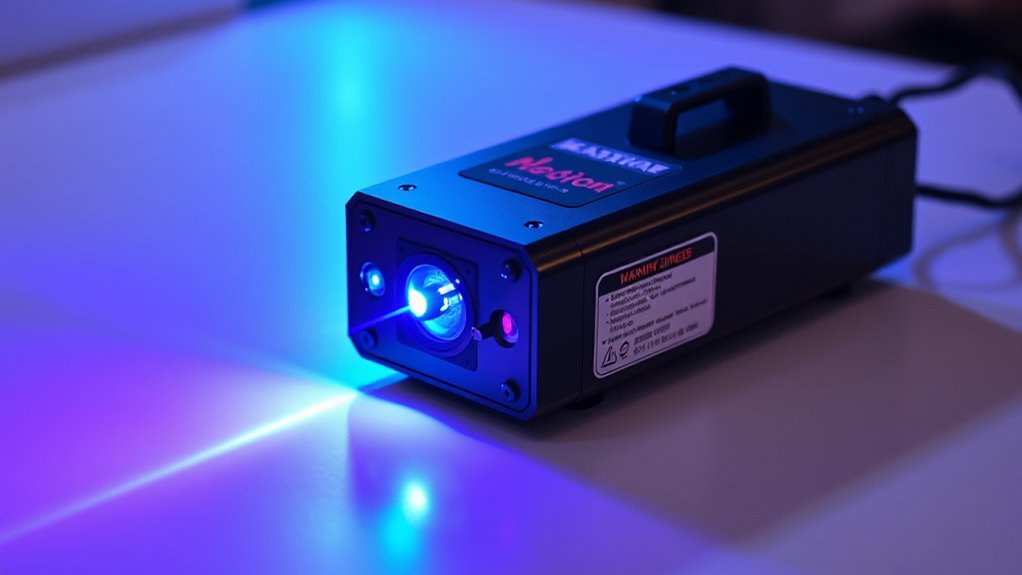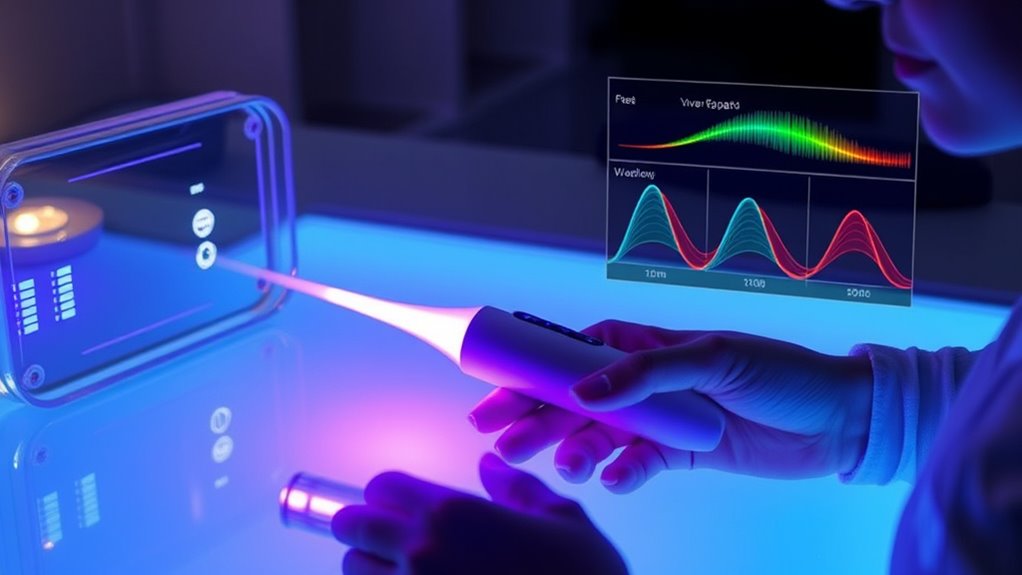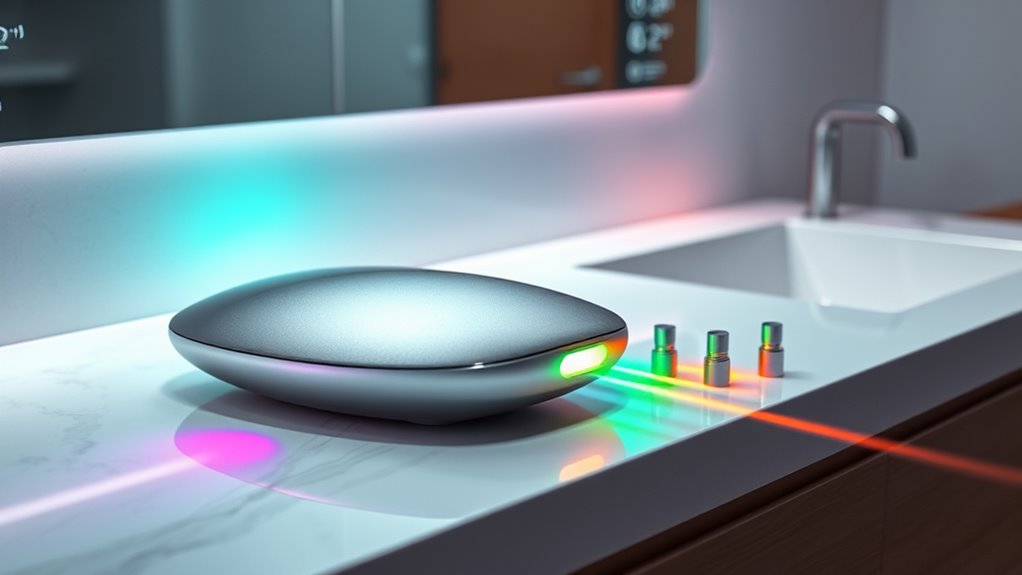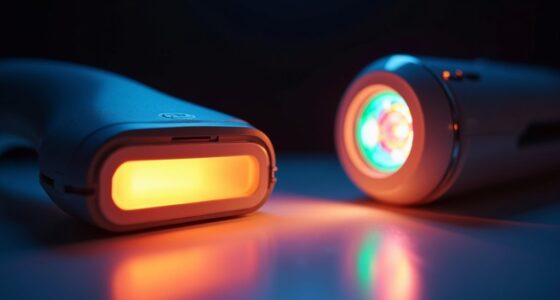The future of at-home laser devices looks promising with new wavelengths on the horizon. These advancements will allow for safer, more personalized treatments targeting skin rejuvenation, pigmentation, sun damage, and hair removal. Multiple wavelengths will make devices more effective across different skin tones and concerns. Plus, innovations in safety features and intuitive design will boost confidence and comfort. If you want to explore how these developments can benefit your skincare routine, there’s more to discover ahead.
Key Takeaways
- Emerging wavelengths will enable more precise, personalized skin rejuvenation and pigmentation correction at home.
- Advances in laser technology will expand device safety features like skin sensors and automatic shut-offs.
- Future devices will incorporate multiple, innovative wavelengths for targeted treatment of various skin concerns.
- User interfaces will become more intuitive, making at-home laser treatments safer and easier for consumers.
- Regulatory updates and technological progress will enhance efficacy across diverse skin tones and improve overall safety.
Understanding Wavelengths in Laser Technology

Understanding wavelengths in laser technology is essential because they determine how lasers interact with your skin. The wavelength influences which skin components the laser targets, affecting safety and effectiveness. Precise control of wavelength ensures laser safety by minimizing damage to surrounding tissue. Wavelength precision allows for tailored treatments, whether targeting hair follicles, pigmentation, or other skin issues. Different wavelengths penetrate the skin to varying depths, so selecting the right one is vital for maximum results. In at-home devices, accurate wavelength calibration helps prevent adverse effects and improves outcomes. As technology advances, the development of lasers with refined wavelengths promises safer, more effective skin treatments. Advancements in laser technology continue to improve wavelength accuracy and treatment customization. Mastering wavelength basics empowers you to understand how these devices work and what to expect from future innovations.
Emerging Laser Wavelengths for Skin Rejuvenation

Recent advances in laser technology are introducing new wavelengths specifically designed for skin rejuvenation, offering more targeted and effective treatments. These emerging wavelengths enhance laser skin tightening and enable precise pigmentation correction, addressing common concerns like fine lines and uneven skin tone. As technology evolves, at-home devices will incorporate these wavelengths for safer, more efficient results. Advanced laser wavelengths are expected to further improve treatment outcomes and personalization options.
Wavelengths Targeting Pigmentation and Sun Damage

Wavelengths targeting pigmentation and sun damage have become essential in at-home laser treatments because they effectively break down excess melanin and even out skin tone. These wavelengths focus on pigmentation correction by targeting hyperpigmentation, age spots, and melasma, reducing their appearance over time. They also help repair sun damage, fading discoloration caused by UV exposure. Modern at-home devices use specific wavelengths that penetrate deeply enough to break up stubborn pigment but remain safe for regular use. By targeting the root causes of pigmentation and sun damage, these treatments promote clearer, more uniform skin. As technology advances, expect more precise wavelengths that deliver better results with fewer side effects, making pigmentation correction and sun damage repair more accessible and effective for home use. Additionally, understanding the Vetted – How Get Divorce can be helpful in managing stress and emotional well-being during skin treatment routines.
Advances in Hair Removal Wavelengths

Advances in hair removal wavelengths have considerably improved the safety and effectiveness of at-home laser treatments. New wavelengths target hair follicles more precisely, reducing skin irritation and increasing treatment efficiency. These innovations also emphasize laser safety, minimizing risks associated with improper use. Additionally, device ergonomics now prioritize user comfort, making treatments easier to perform at home. The table below highlights key factors:
| Feature | Benefit |
|---|---|
| Multiple wavelengths | Customizes treatments for different hair and skin types |
| Improved laser safety | Reduces risk of burns and skin damage |
| Ergonomic design | Enhances user comfort during use |
| Precise targeting | Speeds up hair removal, minimizes discomfort |
| Advanced technology | Ensures more effective and tailored treatments |
These advancements ensure your at-home hair removal is safer, more effective, and easier to manage.
The Role of Multiple Wavelengths in Personalized Treatments

Using multiple wavelengths allows you to customize treatment depths to match your skin and hair type. This approach helps target specific issues more effectively while reducing the risk of side effects. As a result, your at-home laser becomes safer and more personalized for your unique needs. Incorporating the right signs of spoilage can ensure the equipment functions properly and safely over time.
Customizing Treatment Depths
By selecting different wavelengths, at-home laser devices can target specific skin layers more effectively, allowing for personalized treatment depths. This customization enhances treatment efficacy while maintaining laser safety, ensuring you minimize risks associated with improper use. Multiple wavelengths enable you to adjust the intensity and reach of the laser, focusing on surface imperfections or deeper skin issues as needed. Precise control over treatment depth helps you avoid unnecessary damage to surrounding tissues, reinforcing the importance of proper device calibration and adherence to safety guidelines. As technology advances, these customizable options will become more intuitive, empowering you to tailor treatments to your unique skin profile. Understanding sound design principles can also aid in creating informative tutorials or user guides that enhance your experience. Ultimately, this approach maximizes results while prioritizing safety and personalized care.
Targeting Specific Skin Issues
Multiple wavelengths in at-home laser devices allow you to target specific skin issues with greater precision. By selecting the appropriate wavelength, you can effectively treat concerns like pigmentation, redness, or fine lines, customizing your approach. This personalization enhances laser safety by reducing unnecessary exposure to surrounding tissue, minimizing risks. Additionally, multi-wavelength devices are designed with durability in mind, ensuring consistent performance over time despite frequent use. The ability to adapt wavelengths means your device remains effective for various skin types and concerns, making treatments safer and more tailored. As technology advances, expect at-home lasers to incorporate multiple wavelengths that improve both efficacy and safety, empowering you to address multiple skin issues confidently and precisely, right from your home. Incorporating skin-specific wavelengths can further optimize treatment outcomes by targeting unique skin characteristics and conditions.
Enhancing Safety Profiles
The incorporation of multiple wavelengths in at-home laser devices considerably enhances safety by allowing treatments to be precisely tailored to your skin’s unique needs. This customization reduces the risk of side effects and minimizes damage, making treatments safer overall. Advanced user interfaces help you select the appropriate wavelength settings easily, further improving safety and confidence. Additionally, multi-wavelength options boost cost efficiency, as you can address various skin concerns with a single device instead of multiple tools. By adapting treatments to your specific skin type and condition, you minimize unnecessary exposure and optimize results. Furthermore, understanding the potential vulnerabilities in AI models like GPT-4 underscores the importance of integrating robust safety measures in device technology to prevent misuse and ensure user safety. Ultimately, this personalized approach ensures safer, more effective treatments at home, giving you better control and peace of mind during every session.
Safety Considerations for New Laser Wavelengths

As new laser wavelengths are developed for at-home use, ensuring safety becomes even more critical. You need to understand that laser safety involves strict guidelines to prevent accidental injury or damage. Manufacturers must adhere to device regulation standards, ensuring each device is tested for safety and efficacy before reaching consumers. With different wavelengths, risks vary, so proper user education is essential. Devices should include safeguards like automatic shutoffs or skin contact sensors to minimize hazards. As the technology evolves, ongoing regulation updates are necessary to keep pace with new wavelengths. Additionally, implementing AI security measures can help monitor and detect potential device malfunctions or misuse in real-time, further enhancing user safety. Ultimately, prioritizing laser safety and rigorous device regulation helps protect you from potential side effects, ensuring at-home laser treatments are both safe and effective.
How New Wavelengths Enhance Treatment Efficacy

Advancements in laser wavelengths allow for more targeted and effective treatments at home. By carefully selecting wavelengths, devices can target specific skin concerns like pigmentation, hair, or vascular lesions more precisely. This improved wavelength selection enhances treatment efficacy by reaching deeper layers or focusing on particular chromophores, delivering better results faster. It also minimizes damage to surrounding tissue, supporting laser safety. With new wavelengths, you gain more options for customized treatments tailored to your unique skin type and condition. This precision reduces side effects and increases overall satisfaction. As technology advances, these new wavelengths will make at-home laser treatments more powerful yet safer, giving you confidence in achieving professional-grade results with greater ease. Additionally, incorporating Chevrolet Tuning techniques can inspire innovative approaches to optimizing device performance and safety features.
Innovations in Device Design for Home Use

Innovations in device design are transforming at-home laser treatments to be more user-friendly, safe, and effective. New ergonomic designs ensure the device fits comfortably in your hand, reducing fatigue during use. Enhanced laser safety features, like skin sensors and automatic shut-offs, help prevent accidental overexposure, making treatments safer. Smaller, more precise applicators improve targeting, minimizing discomfort and reducing side effects. Intuitive interfaces and clear instructions make it easier for you to operate devices confidently, even if you’re new to laser treatments. These innovations prioritize your safety and comfort, encouraging consistent use while minimizing risks. As device ergonomics improve and safety measures advance, at-home laser treatments become more accessible and reliable, paving the way for broader adoption.
Comparing Professional and At-Home Laser Technologies

Professional and at-home laser technologies differ markedly in power, precision, and treatment scope. Professionals use devices with higher energy levels, making treatments faster and more effective but requiring strict laser safety protocols to prevent injury. At-home devices are designed for lower power to guarantee safety during personal use, but this limits their effectiveness and precision. Device ergonomics also vary considerably; professional lasers are often larger, more complex, and require specialized training, while home devices prioritize compact, user-friendly designs for convenience and safety. These differences mean that professional treatments can handle a wider range of skin concerns with greater accuracy, but at-home lasers are becoming increasingly capable for basic hair removal and skin refinement, provided users follow safety guidelines carefully.
Future Trends and Expectations in At-Home Laser Devices

As at-home laser technology continues to evolve, manufacturers focus on making devices more effective, safe, and user-friendly. Future trends include advanced features that enhance laser safety, such as built-in skin sensors and targeted wavelengths to minimize risks. Expect innovations that improve efficacy while maintaining strict adherence to regulatory approval standards, ensuring safety for consumers. Regulatory bodies will likely update guidelines to keep pace with technological advancements, encouraging safer device development. Wavelength improvements will enable better targeting of specific hair or skin tones, expanding usability. Additionally, user interfaces will become more intuitive, making home treatments easier and more reliable. Overall, these trends aim to deliver safer, more efficient at-home laser devices that meet or exceed current safety standards, providing consumers with confidence in their long-term use.
Frequently Asked Questions
How Will New Wavelengths Improve Treatment Personalization for Users?
New wavelengths will substantially enhance treatment customization for you by allowing more precise targeting of specific skin issues. With improved wavelength precision, you can tailor treatments to your unique skin type and concerns, leading to better results and fewer side effects. This advancement means your at-home laser can adapt to your evolving needs, giving you a personalized approach that maximizes effectiveness while minimizing discomfort and downtime.
Are There Risks Associated With Untested Laser Wavelengths at Home?
They say “better safe than sorry,” and that’s especially true with untested laser wavelengths at home. You face safety concerns and regulation challenges, as new wavelengths might not be proven safe or effective yet. Using unregulated devices could lead to skin damage or other risks. Always prioritize safety and wait for proper testing and approval before trying new laser treatments at home.
Will Future Lasers Be Compatible With Existing At-Home Devices?
You might wonder if future lasers will work with your current at-home device. While device compatibility could improve as technology advances, laser safety remains vital. Manufacturers will need to ensure new wavelengths integrate seamlessly and maintain safety standards. Be cautious about using incompatible lasers, as improper wavelengths can cause skin damage. Stay informed about updates from trusted brands, and always follow safety guidelines to protect yourself.
How Will New Wavelengths Affect Treatment Duration and Frequency?
You wonder how new wavelengths will impact your treatment duration and frequency. These advancements could enhance treatment efficiency, allowing you to see faster results. Wavelength customization means you might tailor sessions to your needs, reducing sessions or increasing effectiveness. As technology evolves, you’ll benefit from more precise treatments, potentially decreasing the overall time and sessions required, making at-home laser treatments more convenient and personalized for your skin goals.
Can Emerging Wavelengths Address Skin Types Currently Limited in Laser Treatments?
Emerging wavelengths could improve laser treatments for more skin types, especially those with varied skin pigmentation, by targeting deeper or different pigment layers more precisely. As you explore these advancements, safety protocols will remain essential to prevent adverse effects. These new wavelengths offer the potential to expand treatment options, making at-home laser devices safer and more effective for diverse skin tones, reducing risks and enhancing results for a broader user base.
Conclusion
As the horizon of at-home laser technology expands, you’re standing at the edge of a new dawn. With new wavelengths revealing personalized, effective treatments, it’s like having a professional clinic right in your home. These innovations are shaping a future where skincare becomes a tailored journey, not a one-size-fits-all path. Embrace this wave of change, and ride confidently into a brighter, more radiant tomorrow. The future of at-home laser is yours to shape.









